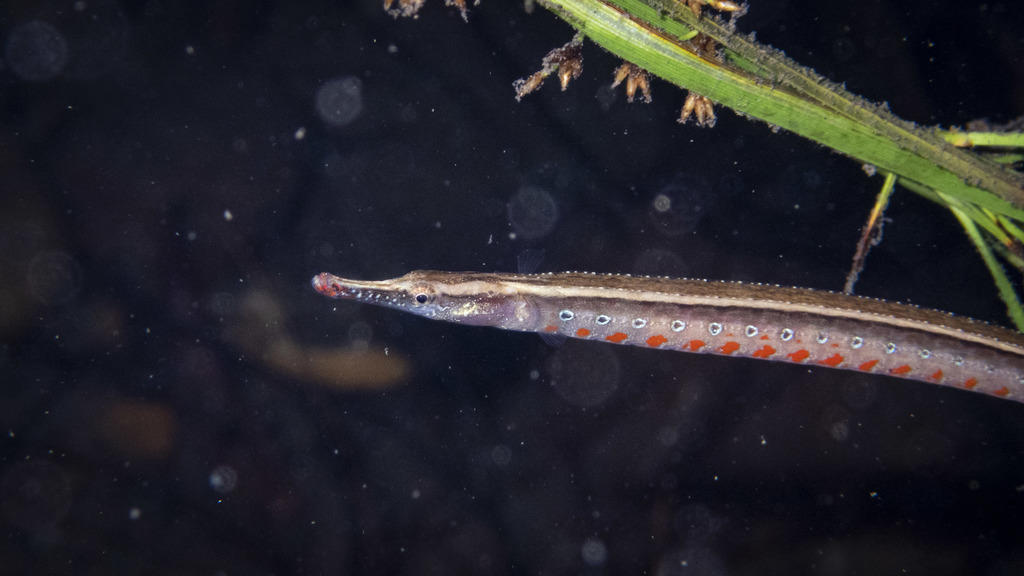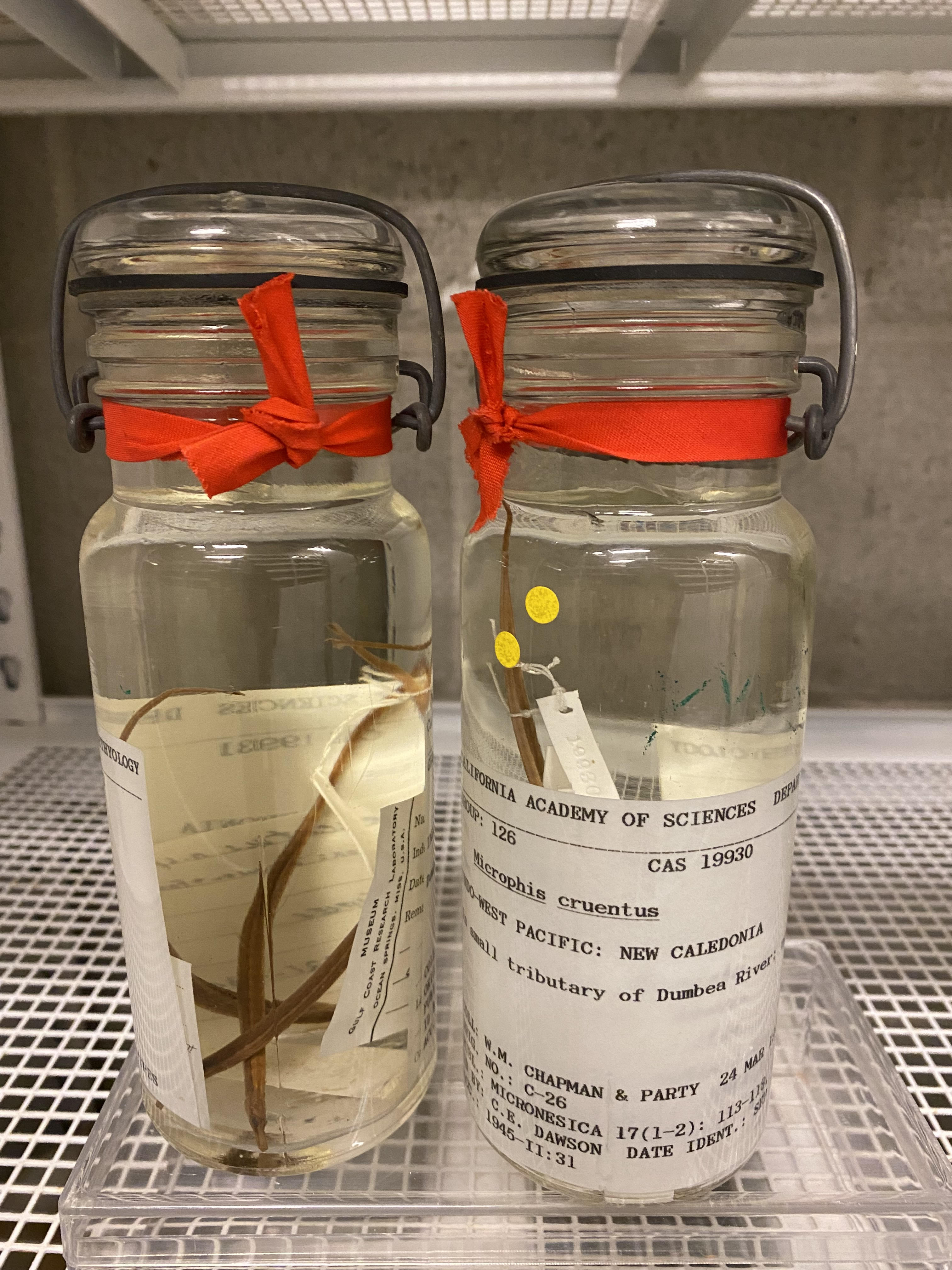The Rediscovery of a Lost Fish on iNaturalist
How can we protect the world’s most threatened species before it’s too late? That’s the goal behind the Search for the Lost Fishes campaign launched this week by Shoal in collaboration with Re:wild and the IUCN-SSC Freshwater Fish Specialist Group. The iNaturalist community is already playing an important role in this work with the re-discovery of what would have been one of the campaign’s top 10 most wanted lost species: the Dumbéa River Pipefish.

The Dumbéa River Pipefish, photographed by Damien Brouste
Pipefish are seahorse cousins that kind of look like what would happen if you uncoiled a seahorse. According to Luiz Rocha, the Follett Chair of Ichthyology at the California Academy of Sciences “The Dumbéa River Pipefish was first described in 1981 from specimens that had been sitting, overlooked, in the California Academy of Sciences and a few other museums since the 1940s.” But soon after it was discovered and named, the Dumbéa River Pipefish once again slipped off of the conservation community's radar and was thought to be extinct.

The Dumbéa River Pipefish specimen collected in 1944 at the California Academy of Sciences, photographed by Luiz Rocha. iNaturalist is a joint initiative of the California Academy of Sciences and the National Geographic Society
“It’s a very serious problem if a species is assumed to be extinct when it is not – because as soon as that happens, all conservation efforts for the species stop,” says Ian Harrison, Co-Chair of the Freshwater Conservation Committee of IUCN Species Survival Commission, “and if it is already threatened then the chances of it actually becoming extinct increase significantly.” This is the motivating premise of the Lost Fishes campaign: to find these lost species before they disappear.
This is exactly what happened in the case of the Dumbéa River Pipefish. As described in this article by the Lost Fishes campaign, the Dumbéa River Pipefish was originally one of the top 10 Lost Species, but while doing research on this species, the team ran across an iNaturalist observation posted last fall by New Caledonian naturalist Damien Brouste (@damienbr) that he photographed alongside Nicolas Charpin (@nicocharpin), an aquatic scientist with the New Caledonian NGO Vies d'Ô Douce in a pool in the Ouenghi River in New Caledonia. Damien has posted over 3,800 observations from New Caledonia to iNaturalist representing 800 distinct species. "I could not imagine a better tool to connect scientists and citizens," Damien told me. “Thanks to iNaturalist, I've been able to meet people sharing the same passion and count them as friends now." Valentin de Mazancourt (@mazancourt), an associate researcher at the French National Museum of Natural History and very active identifier on iNaturalist, noticed the observation and was able to confirm its identification with a Ph.D. student in his lab working on the taxonomy of Indo-Pacific Pipefishes. "Thanks to iNaturalist, researchers now have an amazing network of observers all around the world that allows us to get valuable new data on rare species like this one," says Valentin. "Sometimes from remote places that would have required a lot of effort and resources to reach otherwise".

Damien Brouste naturalizing in New Caledonia
"I’m so thrilled that this gorgeous pipefish has been rediscovered," rejoiced Amanda Vincent, Chair of the IUCN SSC Seahorse, Pipefish and Seadragon Specialist Group. "Now we need to find ways to keep its populations and habitats in good shape. Freshwater pipefishes of the genus Microphis are a particular concern. Of the 24 species in the genus, three are known to be at risk and we can’t even assess 12 other species. It would be wonderful if anybody could share information on the Spinach pipefish, or any of the other Data Deficient species."
By connecting local naturalists such as Damien in New Caledonia with researchers from around the world such as Valentin’s lab at the French National Museum of Natural History, iNaturalist is a powerful tool for rapidly and accurately censusing the Earth’s biodiversity and identifying rare species such as the Dumbéa River Pipefish that are only just hanging on so their protection can be prioritized.
According to Ian Harrison, "finding these fishes can be difficult to do, and time consuming. And that is where citizen science can help: a force of people who are mobilized to help seek out these species, and share information on their observations. iNaturalist is an excellent way of achieving that. The information gathered through iNaturalist can increase our knowledge of the presence of species. By knowing where they are distributed, and what threats are present in these areas, this information can help assess the risk of extinction of these species, for the IUCN Red List of Threatened Species."
The Search for the Lost Fishes campaign will help coordinate these searches for species that haven't been recorded in over a decade, but are yet to be declared Extinct. Shoal's partners will head out to some of the planet's most far-flung freshwaters, from a small town in Iraq to the world's highest lake, from the jungles of Papua New Guinea to central Madagascar, with the aim of rediscovering species of fish so that we may implement a conservation programme to give them every possible chance of future survival. "The goal of Search for the Lost Fishes is to give a second chance to species that, for one reason or another, have fallen off our collective radar. It's an opportunity to celebrate the overlooked fishes on the list, and offer hope for their future. And it's about curiosity and adventure, about encouraging people to get out there and connect with their local waterways to help advance scientific understanding," says Michael Edmondstone, Shoal's Communications and Engagement Lead. "iNaturalist is an ideal fit for this, as it presents the opportunity for passionate naturalists in the field to connect with taxonomic experts around the world. Damien's sighting of the Dumbéa River pipefish is the perfect example of how iNaturalist can connect people and give their observations a global platform."
The Dumbéa River Pipefish may have been found but many lost fishes remain. The Top 10 List released by the Lost Fishes campaign this week includes:
Annamite barb (possibly central Vietnam)
Diyarbakir (Batman River) loach (Turkey)
Duck-billed buntingi (Indonesia)
Spinach pipefish (Papua New Guinea)
Mesopotamian barbel (Eastern Turkey, Eastern Syria, Iran, Iraq)
Syr Darya shovelnose sturgeon (Tajikistan and Uzbekistan)
Titicaca orestias (Peru)
Haditha cavefish (Iraq)
Itasy cichlid (Madagascar)
Fat catfish (Lake Tota basin, Colombia)
If you live or are traveling where any of these species occur, please help us find them. And wherever you live, go outside and use iNaturalist to document the fishes that occur in your neighborhood. You never know what you might find!
Can you also contribute knowledge about seahorses, the immediate relatives of pipefishes? We invite everybody to make contributions to iSeahorse, the iNaturalist partner that tracks seahorse sightings. We value all contributions, which have greatly expanded our understanding of seahorse species’ geographic ranges. We also seek community partners who can undertake long-term monitoring of seahorse populations.







Σχόλια
Wow, what an amazing find. Congratulations!
Wow. What a beautiful fish!!! Well done!
Terrific story!
Makes me want to visit New Caledonia and go snorkeling. Beautiful place.
That's a fantastic story! It is so inspiring to see how iNaturalist brings together all the people needed to enable this rediscovery.
Félicitations Damien !! :)
Awesome! I hope more lost fish are found! The power of iNaturalist is truly amazing!
Amazing, inspiring story!
Great story and a very worthy project. One species of shark that people should be keeping an eye out for is Carcharhinus obsolerus White, Kyne & Harris, 2019. The name literally means extinct Carcharhinus. It is only known from three specimens collected from the Gulf of Thailand, Vietnam and Malaysian Borneo over 80 years ago (https://journals.plos.org/plosone/article?id=10.1371/journal.pone.0209387).
Awesome!! Congrats, @damienbr. Keep doing great contributions to NC fauna <3
Congratulations, and Good Luck!
Awesome Congrats
That is amazing news! Wonderful, inspiring work.
Félicitations, Damien!
Great stuff!! :)
Hooray for all involved, well done!!!
Wow, that is sooo cool! Well done on rediscovering this fish and it is indeed very beautyful!
What a promising story, hope we will see new rediscoveries soon!
That is amazing! Super pretty pipefish as well! Good job!
I'm so happy that this fish is in action again!
Though this great to see I doubt many others on the top ten list will be rediscovered. especially the syr darya sturgeon that things habitat is beyond destroyed.
Great news! iNat's influence just keeps growing!
Absolutely amazing!!!
Damien (@damienbr) since you clearly have a talent for finding lost species perhaps you could rediscover the New Caledonian cat shark (Aulohalaelurus kanakorum). It hasn't been seen since it was described by Bernard Seret in 1990 (https://media.australian.museum/media/Uploads/Journals/17729/110_complete.pdf). No pressure :-)
Προσθήκη σχόλιου